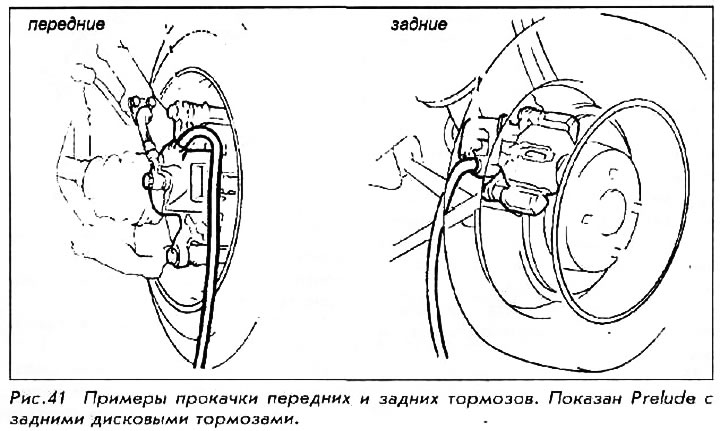WARNING: Vehicles equipped with anti-lock braking systems (ABS), require a separate bleeding procedure if any of the components of this system are removed or pipelines are disconnected. Refer to the section on ABS of this chapter. If repairs are required that do not affect the ABS, such as replacement of the master cylinder, lines or brake hoses, then the normal bleeding procedure can be used.
It is always necessary to bleed the hydraulic system if it has been opened or if air has entered the pipelines. It may be necessary to bleed all four brake systems if air has entered at a low fluid level or when the brake pipes in the master cylinder are disconnected.
If the piping is disconnected at only one wheel, then only bleeding of the brake circuit is usually required, although bleeding of all four wheels is always recommended. If the pipelines were disconnected at any joint between the master cylinder and the brake, then the corresponding circuit must be pumped.
On vehicles equipped with rear drum brakes, unadjusted brake pads can cause "long" pedals and weak braking, creating a feeling of air entering the pipelines. To resolve this problem, adjust the brakes and drive the vehicle before bleeding the system.

1. Fill the master cylinder reservoir with brake fluid to the MAX or FULL mark and retain at least half of the full volume during the bleeding procedure.
2. It is highly recommended to always bleed on all wheels, not just one or two. The correct order of pumping:
- Prelude: Front left, rear right, front right, rear left.
- 1984-89 Accord: Front left, rear right, front right, rear left.
- 1990-91 Accord: Rear right, front left, rear left, front right.
3. On the wheel to be bled, attach a tight-fitting transparent hose while holding the bleed valve with a suitable wrench. Hang and submerge it in a transparent container half filled with clean brake fluid. The end of the hose must remain immersed in the liquid at all times.
4. Ask an assistant to slowly press the brake pedal several times and then keep it pressed.
5. Slowly unscrew the drain valve (usually 1/4-1/2 turn is enough). After the first appearance of escaping air and fluid, close the bleed valve and have an assistant slowly release the pedal.
6. Repeat steps 4 and 5 until no air bubbles are visible in the hose or container. If air constantly appears during repeated pumpings, then the system should be checked for the source of the leak. At the end of the work, the bleeder screw must be tightened by 7-9 Nm.
7. Periodically check the master cylinder reservoir to maintain the proper brake fluid level.
WARNING: Do not reuse brake fluid.
8. After pumping, check the pedal for "sponginess" or other suspicious sensations. Repeat the bleeding procedure if adjustment is necessary. Drain excess liquid from the reservoir.
9. Check the correct functioning of the brakes while driving.
